Customer service complaints are not unexpected, but with DISC, it's possible to better manage them.
 Customers are reaching out to your team members expecting a positive experience; addressing their concerns and solving their issues. What happens when they're unhappy because the outcome of the interaction isn't what they wanted? We can relate because we've all had our own personal experiences, with less than desirable results.
Customers are reaching out to your team members expecting a positive experience; addressing their concerns and solving their issues. What happens when they're unhappy because the outcome of the interaction isn't what they wanted? We can relate because we've all had our own personal experiences, with less than desirable results.
Poor customer service is a deal breaker for many. It impacts how the customer may view the entire organization. Positive customer service builds loyalty and reflects positively on your whole company. Excellent customer service can be the difference between you and the competition. There is always someone else who can offer them the same product or service.
Giving your customer service team a strong start

While it may not be possible to change every outcome; it is possible to better manage the customer's experience by applying DISC. Even if the situation may not end up satisfactorily resolved for both or either sides, the customer may not walk away with additional complaints or feel overly dissatisfied.
DISC helps your staff find ways to engage and respond in ways the customer feels more comfortable and responds more positively; resulting in the best possible outcome. In short, we practice treating the customer the way they want to be treated; whether it's in person, on the phone, or via written communication.
Seems simple enough, but it's not always easy to figure out how the customer wants to be treated. DISC helps your team members get it right from the start, by identifying your customer's preferences. Now your employees have accurate information to make better adjustments in the interaction.
Giving your managers the tools they need
 One way to create a successful team is by providing your managers with critical information to build a better customer service team. How can your managers understand their employees and potential hires in order to better match job roles? How can your managers better manage their team by using their team's strengths, developing challenges, and supporting productive dynamics?
One way to create a successful team is by providing your managers with critical information to build a better customer service team. How can your managers understand their employees and potential hires in order to better match job roles? How can your managers better manage their team by using their team's strengths, developing challenges, and supporting productive dynamics?
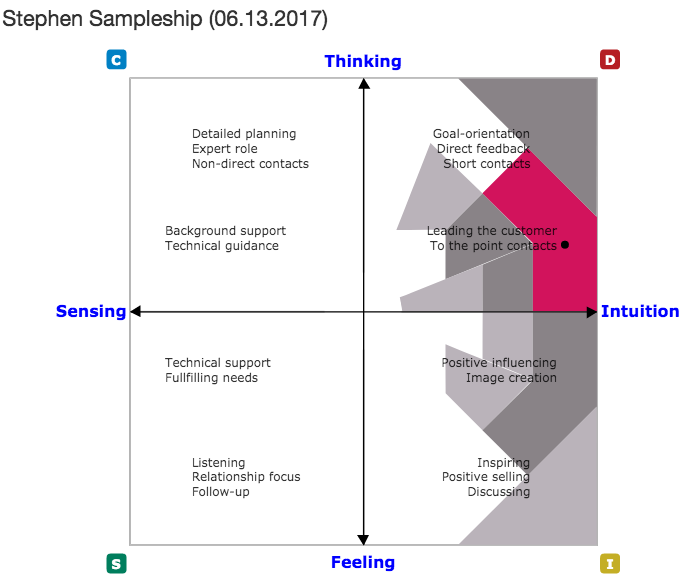 First off, the simple answer is, there is no best style to build a team. DISC cannot predict how successful your employee will be. However, it does predict how the your employee prefers to do things. In addition, your employees bring a unique set of experience, skills, attitude, and knowledge to their jobs. In understanding how your employees prefer to communicate, how they handle pressure, or what support they need, provides you, as a manager, powerful information on how to better manage each employee and your team as a whole.
First off, the simple answer is, there is no best style to build a team. DISC cannot predict how successful your employee will be. However, it does predict how the your employee prefers to do things. In addition, your employees bring a unique set of experience, skills, attitude, and knowledge to their jobs. In understanding how your employees prefer to communicate, how they handle pressure, or what support they need, provides you, as a manager, powerful information on how to better manage each employee and your team as a whole.
You constantly train your people on how to handle difficult customers, understanding your product or service, how to resolve problems, etc.; however, your customers may not want it handled the same way.
DISC helps you recognize there is no best way to handle customer service issues. It's not like you can have all your D-style customers call your D-style team member right? In fact, a standard response can turn off a large segment of your client base.
Each customer interaction needs be recognized as unique where your team members adjust to each situation. This may sound exhausting, but adjustments are often temporary and brief. Better yet, the results from these adjustments become easier over time and tend to be more positive and effective.
Let's take a look at how each main DISC style prefers to approach customer service.
D-style scenario
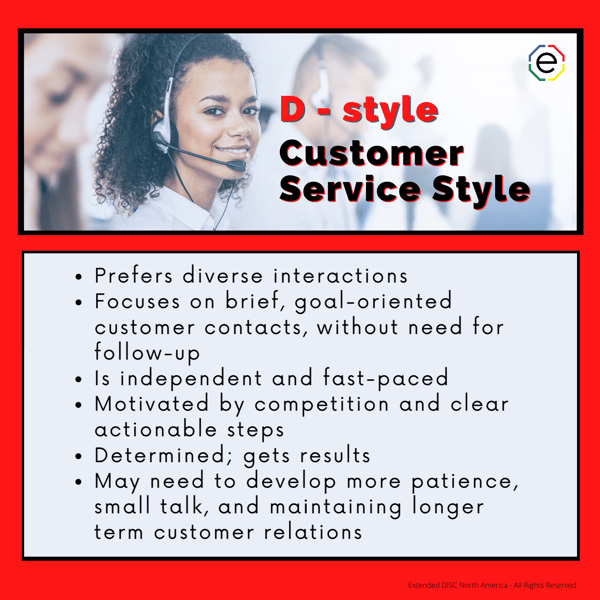 Anyone can succeed in customer service; however, different styles find certain roles more comfortable and motivating.
Anyone can succeed in customer service; however, different styles find certain roles more comfortable and motivating.
Your D-styles prefer briefer and diverse contacts. They are motivated to reach speedy results without too much small talk. They tend to use their self-confidence to lead the contact through actionable steps towards a quick fix.
D-styles can be more impatient and blunt. They can challenge themselves to slow it down, spend some time listening to customer's needs, and focus on longer term customer relations.
I-style Scenario
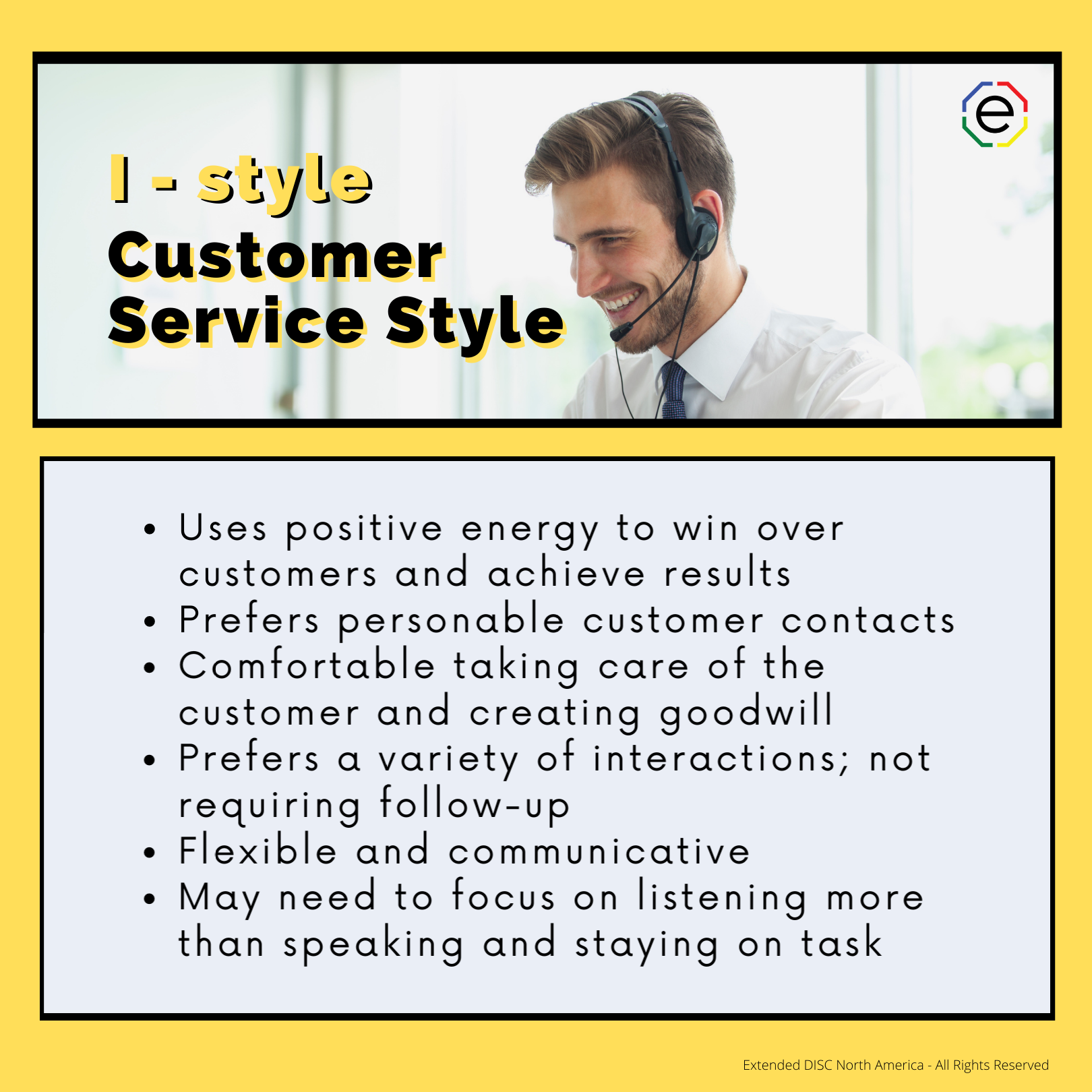
Your I-style employees use their positive energy to influence and win over customers. They enjoy the personable customer contacts and often create goodwill and rapport. They tend to be flexible and responsive.
I-styles react and may jump to decisions too quickly; without time to listen to client's actual issues. They may spend too much time on small talk and overlook the details and actionable steps. Your I-styles can challenge themselves to listen more and stay on tasks.
S-style scenario
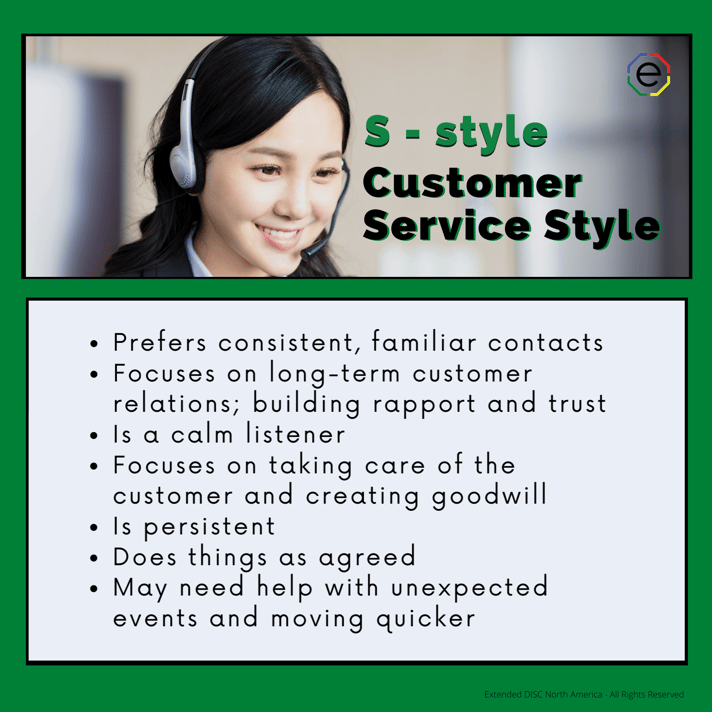
Your S-style employees are calm and supportive listeners. They are seen as helpful, consistent, and and trustworthy. They prefer to take care of the customer and focus on long-term relationships.
However, they may not be direct; may be slow to get to the point and have more trouble saying "no" when they need to. S-styles may not lead the client or offer new solutions; often waiting for their customer to lead. S-styles can challenge themselves to move quicker, focus on task-oriented results, and better manage unexpected events.
C-style scenario
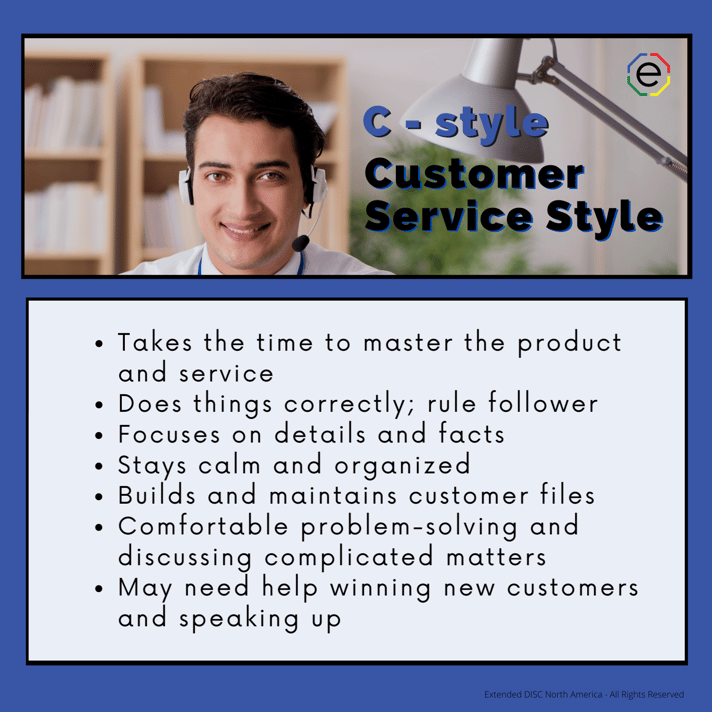
Your C-style employees are careful, conscientious and systematic. They will get to the root of the issue; wanting to know the "why" and details of the problem. They will take the time to understand and master the product and service. You can count on them to follow the rules and discuss complicated matters.
C-styles may need help winning new customers and taking a more active role. They may be less comfortable with casual chatting, speaking up, and handling conflict. C-styles can challenge themselves to build rapport with clients and manage unexpected situations.
Why your customer service team gets into trouble
Your team gets into trouble when they manage each interaction in the same or only in their most comfortable way of doing things; misunderstandings and frustrations on both sides often ensue.
DISC helps us to understand our behavioral styles are different. It also helps us understand how we tend to show up and come across to others and how to recognize the styles of others. Most importantly, it reminds us to use the information to adjust more effectively.
Each time your customers have positive experiences, the more likely they become a loyal client. In addition, a great experience can increase the customer base because they are likely to share their experiences with others. Remember, they are even more likely to share negative experiences so give your employees the tools they need to create positive customer service interactions.
DISC can help your customer service team succeed without getting in trouble.

